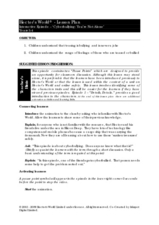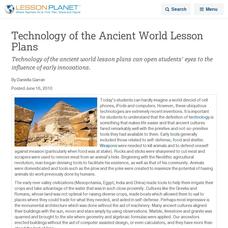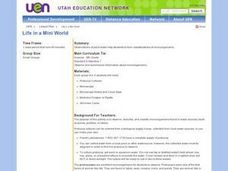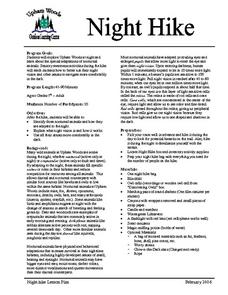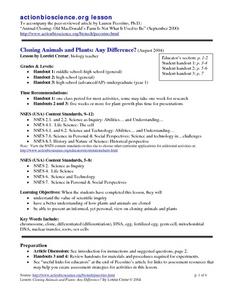Biology Junction
Flatworms
In this flatworms instructional activity, high schoolers identify and color the different parts of a flatworm. They complete 14 short answer questions related to the topic.
Curated OER
Dibble Pond Ecosystem
Students collect specimen and analyze it. In this biology lesson, students analyze and evaluate the diversity found in specific environment. They use the correct terminology as they do their write up for the experiment.
Curated OER
Build a Polyp
Students research coral polyps. In this coral polyps lesson, students discover the anatomy of a coral polyp and how they feed. Students create an edible coral polyp model.
Curated OER
Hector's World Cyberbullying: You're Not Alone
Students watch an episode of Hector's world regarding cyber-bullying and begin to understand what hurtful actions are in relation to someone's feelings. In this Cyber-bullying lesson, students are introduced to the idea of good character...
Curated OER
Hector's World Cyber-bullying: You're Not Alone
Learners discuss cyber-bullying and how it relates to their emotional state. In this cyber-bullying lesson, students watch a short video that identifies how cyber-bullying occurs. Learners participate in an active learning...
Curated OER
Technology of the Ancient World Lesson Plans
Technology of the ancient world lesson plans can open students' eyes to the influence of early innovations.
Curated OER
Health Careers
Each of the 9 slides have a list of possible careers within areas of the Health industry. There are no explanations or details of any of the jobs and so this would be useful to introduce the areas and then let the students research...
Curated OER
Lesson 10: Karyotypes
Students predict traits of future offspring. In this biology instructional activity, students study karyotyping to predict genetic disorders. They research an assigned karyotype and present information about it.
Curated OER
Virus Tracker
Sixth graders will simulate the spread of a virus such as HIV through a population by "sharing" (but not drinking) the water in a plastic cup with several classmates. Although invisible, the water in a few of the cups will already be...
Curated OER
Foods for Better Health
Learners define biotechnology and discuss the economic impact of biotechnology. They also describe what a 1015 onion and a slow-softening tomato are and how they are produced. They examine the safety of genetically-engineered or altered...
Curated OER
Feedback and Flowcharts
Sixth graders explain what a negative feedback system is and they distinguish it from a positive feedback system. They describe examples of how negative feedback is used in both nature and technology. , Students define homeostasis, and...
Curated OER
Types of Reactions
In this reactions worksheet, students describe combustion as either exothermal or endothermal. Students balance reactions and label the types of reactions. This worksheet has 1 multiple choice, 2 short answer, and 10 problem solving...
Curated OER
Recycling Vocabulary Fill Puzzle
In this recycling vocabulary learning exercise, students use a set of recycling definition clues to complete a crossword puzzle. A reference web site is given for additional activities.
Curated OER
Invertebrates
In this invertebrates worksheet, students read about the characteristics of the different groups of invertebrates. Then students complete 10 multiple choice questions.
Curated OER
Sponges and Cnidarian Crossword Puzzle
In this marine science instructional activity, students complete a crossword puzzle with 32 questions on sponges and cnidarian. They identify the different characteristics of sponges and cnidarian.
Curated OER
Food Web Relationships
In this food web learning exercise, students create a food web matrix and answer short answer questions about the food chain according to the matrix. Students complete 7 short answer questions.
Curated OER
Viruses
In this biology lesson, students complete a crossword puzzle with 35 questions about viruses. They identify the different types of viruses and the diseases they bring.
Curated OER
Life in a Mini World
Sixth graders observe, describe, and classify microorganisms found in water sources. In small groups, they make their own slide, observe the Protozoa under a microscope, and record and classify the microorganisms.
Curated OER
Night Hike
Students explore Upham Woods at night and investigate about the special adaptations of nocturnal animals. They identify three nocturnal animals and how they are adapted to the night. Students explain what night vision is and how it works.
Curated OER
The Six Kingdoms
In this kingdoms worksheet, students compare the six different kingdoms. Students complete 2 short answer questions based on this information.
Curated OER
History of the Battery
Students study the development of batteries. In this electrochemistry lesson, students compare the different types of batteries. They explore its applications especially in the medical field.
Curated OER
The Life Cycle of a Flowering Plant
In this flowering plant worksheet, students will review vocabulary words associated with the life cycle of flowering plants. This worksheet has 7 matching and 3 short answer questions.
Curated OER
Meat, Poultry, Fish, Eggs: Constructing and Maintaining
Pupils investigate meat as a source that provides protein, iron and nutrients in the diet. They identify types of meat and their sources, complete a market survey, conduct a fried egg experiment, and prepare various recipes that include...
Curated OER
Cloning Animals and Plants: Any Difference?
Students examine the process in which plants and animals are cloned. They compare and contrast the two procedures and determine if there is a difference. They share their views on cloning to the class.






